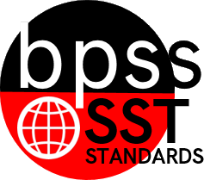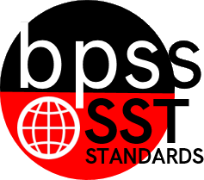SST-08.1
 Standard 1: Standard 1:
Skills and Resources
Students apply Social Studies skills and resources.
|
Narrative for the Skills and Resources
In the future this will contain narratives and other information about the Standard.
Calculation Method for Standards
Standards are larger groups of related benchmarks. The Standard Grade is a calculation of all the related benchmarks. Click on the benchmark name below each Standard to access the learning targets and proficiency rubrics for each standard's related benchmarks. |
|
SST-08.1.01 |
8th Grade SST Targeted Benchmarks
Standard 1: Skills and Resources
SST-08.1.01 Interpret current North Dakota thematic maps (e.g., soils, climate, vegetation, water, climate) to identify where people live and work, and how land is used.
|
Student Learning Targets:
Knowledge Targets
- I can recall vocabulary related to North Dakota geography.
Reasoning Targets
- I can analyze current ND thematic maps.
Skills (Performance) Targets
- I can use thematic maps to identify where people live and work and how land is used in ND.
Product Targets
- I can construct a map of ND with North Dakota's major cities and geographical features.
Proficiency Scale
| Score |
|
Description: ND-SST: 8.1.1 Interpret current North Dakota thematic maps (e.g., soils, climate, vegetation) to identify where people live and work, and how land is used |
Sample Activity
|
| 4.0 |
In addition to Score 3.0, the student demonstrates in-depth inferences and applications regarding more complex material that go beyond end of instruction expectations. |
- |
| |
3.5 |
In addition to Score 3.0 performance, the student demonstrates in-depth inferences and applications regarding the more complex content with partial success. |
| 3.0 |
"The Standard.” The student demonstrates no major errors or omissions regarding any of the information and processes that were end of instruction expectations.The student:
- can analyze current ND thematic maps (e.g., soils, climate, vegetation, population, energy).
- can use thematic maps to identify where people live and work and how land is used in ND.
- can construct a map of ND with North Dakota's major cities and geographical features.
|
- |
| |
2.5 |
The student demonstrates no major errors or omissions regarding the simpler details and processes (Score 2.0 content) and partial knowledge of the more complex ideas and processes (Score 3.0 content). |
| 2.0 |
The student demonstrates no major errors or omissions regarding the simpler details and processes but exhibits major errors or omissions regarding the more complex ideas and processes (Score 3.0 content).The student:
- recognizes or recalls specific terminology, such as:
- some major components of thematic maps
- vocabulary related to North Dakota geography.
- performs basic processes, such as:
- label ND's major cities and geographical features
|
- |
| |
1.5 |
The student demonstrates partial knowledge of the simpler details and processes (Score 2.0 content) but exhibits major errors or omissions regarding the more complex ideas and procedures (Score 3.0 content). |
| 1.0 |
With help, the student demonstrates a partial understanding of some of the simpler details and processes (Score 2.0 content) and some of the more complex ideas and processes (Score 3.0 content). |
- |
| |
0.5 |
With help, the student demonstrates a partial understanding of some of the simpler details and processes (Score 2.0 content) but not the more complex ideas and processes (Score 3.0 content). |
Resources
Websites
Vocabulary
- Provided by individual teachers
|
|
SST-08.1.02
|
8th Grade SST Targeted Benchmarks
Standard 1: Skills and Resources
SST-08.1.02 Use various primary and secondary resources (e.g. historical maps, diaries, speeches, pictures, charts, graphs, diagrams, timelines specific to North Dakota) to analyze, and interpret information.
|
8th Grade US History Student Learning Targets:
Knowledge Targets
- I can identify the differences between primary and secondary resources in US History.
- I can gather appropriate primary and secondary resources for the assigned task in each unit of study.
- I can follow directions when utilizing primary and secondary resources.
- I can recognize or recall specific terminology based upon each unit of study (e.g., Magna Carta, Declaration of Independence, Bill of Rights).
- I can recognize or recall specific phrases based upon each unit of study (e.g., "Four Score and Seven Years Ago").
Reasoning Targets
- I can analyze and interpret primary and secondary resources that influence each unit of study.
Skills Targets
- I can demonstrate extended knowledge and understanding by independently and consistently connecting this standard to real world situations.
- I can utilize several types of primary and secondary resources that will support making inferences to each unit of study.
8th Grade US History Proficiency Scale
| Score |
|
Description: ND-SST: 8.1.2 Use various primary and secondary resources (e.g., historical maps, diaries, speeches, pictures, charts, graphs, diagrams, time lines specific to ND) to analyze and interpret information |
Sample Activity
|
| 4.0 |
In addition to Score 3.0, the student demonstrates in-depth inferences and applications regarding more complex material that go beyond end of instruction expectations.
The student:
- demonstrates extended knowledge and understanding by independently and consistently connecting this standard to real world situations.
|
- |
| |
3.5 |
In addition to Score 3.0 performance, the student demonstrates in-depth inferences and applications regarding the more complex content with partial success. |
| 3.0 |
“The Standard.” The student demonstrates no major errors or omissions regarding any of the information and processes that were end of instruction expectations.
The student can:
|
- |
| |
2.5 |
The student demonstrates no major errors or omissions regarding the simpler details and processes (Score 2.0 content) and partial knowledge of the more complex ideas and processes (Score 3.0 content). |
| 2.0 |
The student demonstrates no major errors or omissions regarding the simpler details and processes but exhibits major errors or omissions regarding the more complex ideas and processes (Score 3.0 content).
The student can:
- identify the differences between primary and secondary resources in US History.
- gather appropriate primary and secondary resources for the assigned task in each unit of study.
- follow directions when utilizing primary and secondary resources.
- recognize or recall specific terminology based upon each unit of study (e.g., Magna Carta, Declaration of Independence, Bill of Rights).
- recognize or recall specific phrases based upon each unit of study (e.g., "Four Score and Seven Years Ago").
|
- |
| |
1.5 |
The student demonstrates partial knowledge of the simpler details and processes (Score 2.0 content) but exhibits major errors or omissions regarding the more complex ideas and procedures (Score 3.0 content). |
| 1.0 |
With help, the student demonstrates a partial understanding of some of the simpler details and processes (Score 2.0 content) and some of the more complex ideas and processes (Score 3.0 content). |
- |
| |
0.5 |
With help, the student demonstrates a partial understanding of some of the simpler details and processes (Score 2.0 content) but not the more complex ideas and processes (Score 3.0 content). |
8th Grade US History Resources
Websites
Vocabulary
8th Grade ND Studies Learning Targets:
Knowledge Targets
- I can identify the difference between primary and secondary resources in North Dakota Studies.
- I can recognize or recall specific terminology, such as: primary and secondary source.
Reasoning Targets
- I can analyze historical maps and evaluate their importance in different time periods.
- I can analyze political cartoons and synthesize the author’s point of view.
Skills Targets
- I can use secondary resources to analyze and interpret information.
- I can use primary resources to analyze and interpret information.
Product Targets
- I can design a media project that effectively interprets primary and secondary resources.
ND Studies Proficiency Scale
| Score |
|
Description: ND-SST: 8.1.2 Use various primary and secondary resources (e.g., historical maps, diaries, speeches, pictures, charts, graphs, diagrams, time lines specific to ND) to analyze and interpret information. |
Sample Activity
|
| 4.0 |
In addition to Score 3.0, the student demonstrates in-depth inferences and applications regarding more complex material that go beyond end of instruction expectations. |
- |
| |
3.5 |
In addition to Score 3.0 performance, the student demonstrates in-depth inferences and applications regarding the more complex content with partial success. |
| 3.0 |
“The Standard.” The student demonstrates no major errors or omissions regarding any of the information and processes that were end of instruction expectations.
The student:
- can identify the differences between primary and secondary resources in North Dakota Studies.
- can use primary sources to analyze and interpret information in North Dakota Studies.
- can use secondary resources to analyze and interpret information in North Dakota Studies.
|
- |
| |
2.5 |
The student demonstrates no major errors or omissions regarding the simpler details and processes (Score 2.0 content) and partial knowledge of the more complex ideas and processes (Score 3.0 content). |
| 2.0 |
The student demonstrates no major errors or omissions regarding the simpler details and processes but exhibits major errors or omissions regarding the more complex ideas and processes (Score 3.0 content).
The student:
- recognizes or recalls specific terminology, such as: primary and secondary source.
|
- |
| |
1.5 |
The student demonstrates partial knowledge of the simpler details and processes (Score 2.0 content) but exhibits major errors or omissions regarding the more complex ideas and procedures (Score 3.0 content). |
| 1.0 |
With help, the student demonstrates a partial understanding of some of the simpler details and processes (Score 2.0 content) and some of the more complex ideas and processes (Score 3.0 content). |
- |
| |
0.5 |
With help, the student demonstrates a partial understanding of some of the simpler details and processes (Score 2.0 content) but not the more complex ideas and processes (Score 3.0 content). |
ND Studies Resources
Websites
Vocabulary
- Provided by individual teachers
|
|
 BPS District Social Studies Standards Book
BPS District Social Studies Standards Book

 Standard 1:
Standard 1: